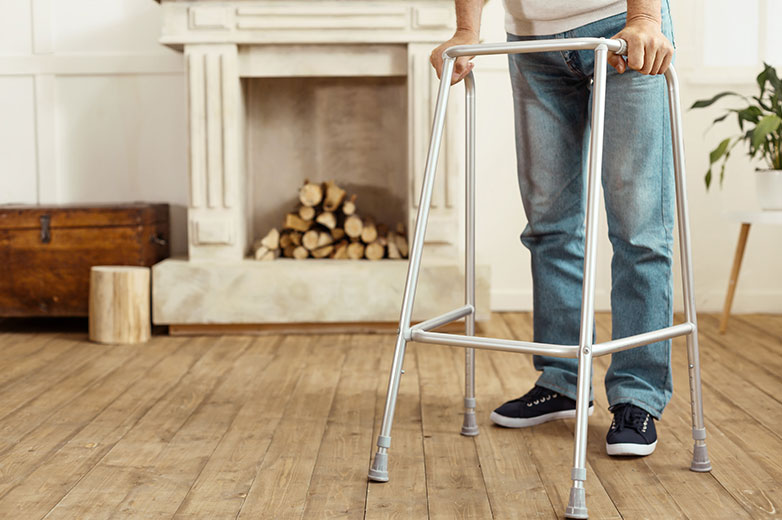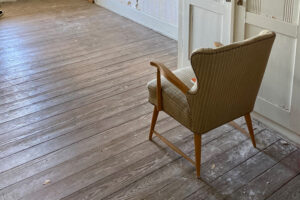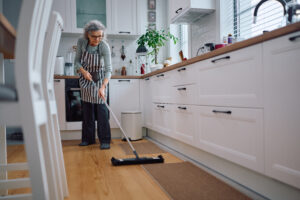
Senior Safe Flooring
Losing mobility as we age can have many knock-on effects, including impacting the type of home flooring we need.
When using walkers, mobility aids and wheelchairs inside, floor coverings that allow for ease of movement are essential.
Seniors may also be more likely to fall, highlighting the importance of slip resistant surfaces to stay safe. This type of flooring can not only minimise the risk of falling, but can also reduce the risk of serious injury.
In essence, flooring is a safety issue that needs to be taken seriously as we age. It’s so crucial, some National Disability Insurance Scheme (NDIS) participants can use NDIS funding to upgrade their home flooring.
As we get older, cleaning and repairing floors can become more challenging too, so low maintenance options are best.

Factors to consider when selecting senior-safe flooring
Textured / slip resistant
Opting for floors that reduce the chances of slipping means embracing flooring with texture. This is a must so mobility aid wheels can easily grip the floor. Not enough texture and slipping and skidding can occur; too much texture and mobility aids can’t glide as needed.
Firm & Stable
When we age, it’s imperative our floors are firm enough to handle the weight of whichever mobility device we need to use. If it’s not firm, floors can be damaged and mobility aids can be unbalanced, causing falls. Flooring that is bonded to the subfloor enhances stability and safety.
Smooth & Flat
While slip resistant flooring has a textured quality, flooring that’s overly textured or bumpy can cause issues, so think smooth. Joins should also be seamless, so wheels don’t get stuck. Uneven surfaces and floor slopes can also trigger falls, so keep it flat wherever possible.
Rugs & mats
Floor rugs and mats can be trip and fall hazards, so avoid them unless they’re fit for purpose ie. anti-slip floor mats with non-slip rubber backing may be safe.

Flooring style spotlight
Contemporary vinyl flooring is a solid choice for using with mobility aids as it’s stable and usually flat. It’s also easy to maintain, affordable, and there are many colours and styles to choose from, including thicker commercial vinyl options offering increased durability.
Carpet, which is generally slip resistant, may be suitable if it’s carefully selected. It can’t be overly thick or plush, though. Commercial-grade options are usually better for using with mobility aids. Avoid carpet tiles as they’re likely to be unsafe, and ensure any carpet is well bonded to the subfloor.
Hybrid flooring – a fusion of laminate and vinyl – offers a stable, rigid surface for mobility aids to navigate. It’s also waterproof, durable, easy to take care of and scratch and stain resistant. It’s also an excellent option for obtaining a stylish hardwood look without the maintenance.
Engineered floorboards are solid enough for walkers, wheelchairs and rollators and tend to be nice and flat, but softer to land on if a fall occurs. Harder woods usually experience less wear and tear and are better able to withstand extra weight. They also offer a degree of texture to help reduce slips and falls.
For further advice, chat to one of Parrys friendly team members today.
Read More Blogs
Article Topics
Recent Articles
-
![Parrys Carpets: How to Select Flooring Based on your Lifestyle]()
How to Select Flooring Based on your Lifestyle
When selecting flooring for your home, letting your unique lifestyle lead the way to your...
Keep Reading -
![Parrys Carpets: 8 Signs It’s Time To Replace Your Old Floors]()
8 Signs It’s Time To Replace Your Old Floors
If you can’t decide if the time is right to invest in some fabulous new...
Keep Reading -
![Parrys Carpets: Struggling with streaky flooring?]()
Struggling with streaky flooring?
If you love a pristine floor, streaking can be incredibly frustrating. Fixing it is simple,...
Keep Reading



